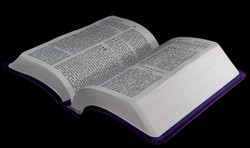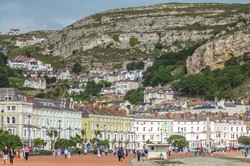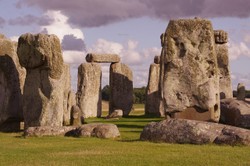Historian Eamonn Duffy is an expert on the Reformation and has written a book that stands alongside his other works on this subject of his expertise. The book, a tome of over four hundred pages of detailed, but highly readable prose, is subtitled Catholics, Protestants and the Conversion of England. The subtitle instantly challenges. For Catholics England did not need converting, and for Protestants there is a question about why Catholics should have a role in converting the country in what they regard as an essentially Protestant process. But Duffy's magisterial command of his subject matter challenges both sides and asks serious questions.

Reformation Divided: a review
by frankbeswick
Professor Eamonn Duffy has written an outstanding insight into the English Reformation that is informative and interesting.
Part One.
The book is divided into three parts preceded by an introduction. Duffy cites two thinkers who have challenging opinions on the subject. One is the American Brad Gregory, who controversially believes that the Reformation had a damaging effect on European religion, undermining the cohesion of European intellectual life with ill-consequences in our time, a challenge to the stale nostrum that the Reformation was a good thing. Duffy also cites Bossy who challenges the view that Post-Reformation English Catholicism was the survival of an old religion, for it should be regarded as a reform with a substantial element of novelty about it. This is a challenging position that is pertinent to the contents of the book.
But the bulk of Part One is focused on Thomas More and his struggles with Protestantism Since Hilary Mantel's onslaught on More in her novel Wolf Hall, More has suffered a bad press, and while Duffy does not take an uncritically favorable view of More's role as a heresy hunter [though not an inquisitor, a role reserved for priests, ] he locates More's abandonment of his Erasmian tolerance in an awareness, whether prescient or not, of the social, political and moral consequences of heresy, which More regarded as threat to the stable political order that the Catholic Church had been attempting to maintain since the fall of the Roman imperium. More saw the Protestant Reformation's belief in predestination as a threat to individual moral responsibility, as it led to a casual acceptance that responsibility for sin would be beyond the powers of the individual sinner. While Protestants challenge this view as simplistic, predestination tends to lead to this consequence and can lead those who accept it to despair or its evil twin presumption. More was also right to some extent over his prediction that social disorder would ensue from the fall of the authority of the Roman Church, as he regarded the murderous exploits of the Anabaptists in Munster in the fifteen twenties as a justification of his point, though universalizing the prediction would lead to a rebuttal of what would be an unjustified universal statement.
Duffy therefore sets More's heresy hunting exploits in the context of a genuine fear of social disorder and a conviction that only the social and political order provided by the Roman Catholic Church would stand against it. He shows More to be a figure far different from the bigot depicted in the work's of Mantel. Duffy speaks positively of Mantel's literary talents, but I suspect that Duffy is damning with faint praise. .
The book does not focus on More's martyrdom, so it avoids controversial and unproductive discussions of his character and sainthood, but instead makes inroads into the discussions of his literary works, challenging the Reformation estimate of his theological works as hasty and religiously unproductive, as he cites both Protestants and Catholics who find them worthy of citation in their works on occasion.
Part Two
The book works on the analysis of significant characters, and thus it does not provide accounts of people whose characters were not important. Thus Edward the Sixth, whose life as a short-lived political tool of great Protestant nobles left little scope for his character to blossom, and Cranmer, whose fickle side changing does him no credit, get little attention. Instead he focuses in this section on heroes of the Catholic Counter-Reformation, such as Cardinal Poles and Allen, and the highly intellectually blessed Gregory Martin. Much of the action in this section takes place in Douai [pronounced Dowy] the refugee Catholic religious college in Northern France founded by Allen. Pole plays an important role in the account of the short-lived Marian restoration and subsequent Catholic action in Europe after he fled on the accession of Elizabeth the First. As a relative of the queen and a potential claimant to the throne safety lay in his distancing from Elizabeth's England.
More chapters in this part deal with Cardinal Allen, an outspoken young man in age when outspoken folk tended to lose their heads [literally] his family and friends advised him to go abroad. It was an inspired choice, for he became a priest. Allen, who had been to Oxford University, is sometimes belittled as a less than top class mind, but this sneering dismissal overlooks his real talents. He was an organization man whose vision for a Catholic College in France to train clergy for the Catholic mission to reconvert England was realized by his energy and determination in the face of often serious odds. Allen sent many priests on this mission, though he never went himself, he was too high profile for that role.
Another significant intellectual was Gregory Martin, a prolific and effective writer and scholar who wrote theological and devotional works and was responsible for much work in the development of Rome as a site of religious tourism and pilgrimage. Sadly, the hugely talented Gregory died at forty years of age of a serious illness, so his potential was never fully realized.
This section tends to have a biographical component, but that is in the early part of it. But after dealing with Gregory it gives a detailed account of the travails and successes of not only Douai but of the Catholic mission and the colleges associated with it. There were more than Douai, and the English colleges in Rome and Lisbon, along with Valladolid in Spain, are notable for their long history. A historically useful element in this section is the oft-overlooked rivalry between the English secular clergy and the religious orders, notably the Jesuits, about the issue of Jansenism, a strict form of Catholicism influenced by Calvinism that had originated in the Netherlands and was influential in France. These struggles are oft-overlooked by English Catholics, and so this section is useful for neglected historical knowledge. The period covered by the book ends before Catholic emancipation in the nineteenth century, so Cardinal Newman's work remains untouched by this work.
Part 3
Up to this part the book has focused on Catholic characters, but to neglect Protestants would be narrow minded, and just as there were devout Catholics who struggled for the reconversion of England, so there were Protestants who took their religion seriously and strove to convert Catholics, but more often to offer salvation to the unchurched multitude, many of whom had little faith and what they had was shattered by the onslaught on the Catholic church. Little effort seems to have come from official Church of England sources, but Duffy details the ardent efforts of a range of Protestant ministers, notably one named Richard Baxter, to develop the religious lives of their parishioners. Baxter and those who followed his teachings were not content with the standard Protestant method of relying on preaching, preach though they did, but they created an organized campaign of catechetics, [teaching of doctrine] which they taught by a thorough campaign in the parishes. This campaign continued though the period of parliamentary control under until the restoration of the monarchy and the Church of England in 1662, when the expulsion of many ardent Protestant preachers caused it to fail.
Yet the Protestant effort did not end, for there was a large literary campaign by religious devotees to take advantage of the growing literacy of the English population to produce what were known as chap books. The word chap prefixed to a word is on older English way of saying cheap. There was in England quite a surge of chap books during the late seventeenth century, often on religious subjects. Duffy suggests that many of the authors were "reformed" ministers ejected from their livings at the restoration and that these ministers were looking to carry on their ministries and also pocket some cash. Duffy also gives a serious account of the founding of the SPCK, Society for the Propagation of Christian Knowledge, still operating, which attempted to publish higher quality Christian literature from a Protestant standpoint.
The book concludes with an account of George Fox, the founder of the Society of Friends, commonly known as the Quakers, of whom Duffy gives a substantial and friendly account. You get the feeling that the writer has a very high regard for Fox and the early members of the Quaker movement.
In fact, when we reflect on Reformation Divided we note that Duffy seems to select the characters on whom he concentrates from basically good characters. Villains such as Thomas Cromwell and the Protestant aristocrats who manipulated the young king Edward the Sixth, are mentioned but are not subjects on which Duffy concentrates. Sincere religious people such as Baxter, Fox and Allen are the people who inspire his interest.
This is a good book well worth reading. I commend it to readers.
I am an Amazon Associate and earn money from qualifying purchases on this page.
You might also like
A Strong Woman's StoryJane Evans went to War, but fought no one, for her mission was mercy and kind...
Sarn Helen. Through Wales on footSarn Helen is a Roman route which travels Wales from South to North, and the...
Surprise at StonehengeArchaeologists have puzzled about the origins of the stones at Stonehenge. Bu...






 Pilgrimage. A review16 days ago
Pilgrimage. A review16 days ago
 Leo the Fourteenthon 05/09/2025
Leo the Fourteenthon 05/09/2025
 The Melsonby Hoardon 03/25/2025
The Melsonby Hoardon 03/25/2025




Comments
For lectures they would have used Latin, but the other languages would have been picked up over time.
That first paragraph under your Part Two subheading particularly catches my attention about the courage in relocating to a strange place. It generates all sorts of questions, such as ones about language.
Might the refugee residents already have known French for Douai and Reims, Italian for Rome, Portuguese for Lisboa and Spanish for Valladolid? Or might they have gotten by with Latin in all four instances? Or might they have persisted with English?
I think that these places were where the refugees could find suitable accommodation.I don't think that they had relatives there. There were other colleges, i.e. Rome, VALLODALID IN Spain and Lisbon. Portugal has been a long term ally of England.
It intrigues me that Douai and Reims included among their populations refugees from England. The two centers log distances that look rather terrain- and time-challenging.
What might have encouraged Reformation refugees to locate there?
Was it that the resident populations were kind to outsiders? Or was it that those who relocated had family, friends and relatives there?
At times of tension in North France the college temporarily relocated in Reims. Finally in the early nineteenth century when the side the situation in France was bad the college removed to England
The first paragraph in your Part Two mentions Douai.
The latter site offers safety from those attempting to harass or retrieve the refugees, what with its location substantially inward from north-France coastal access by the English Channel.
Was there ever any attempt to end or stress the relocation of Douai-based refugees?
Correct on both counts. He was the son of Magaret Pole and the executioner had to chase her round the block.
The first paragraph in your second subheading, Part two, considers the contributions of Cardinals Allen and Pole.
Is the former the Cardinal Reginald Pole, son of Margaret Pole?
One of the English history stories on this, western-side of the (Atlantic) pond portrayed Countess of Salisbury making her executioner run after her around the execution block.
Would that be a true happening?
There is no evidence that the murder of unsuccessful claimants to the throne ever happened in the British Isles. I know of no instances of families retaliating against an executioner. But while the families of executed people did not suffer punishment, shunning was likely
It may not have been carried out often or thoroughly but some Asian countries have a tradition of killing everyone in the family when there was a monarchical overthrow.
Might the British Isles have gone through such a practice regarding power changes and regarding those deemed unacceptable for their money- or power-holding positions?
It seems to me not to be the case monarchically if I consider such happenings as Anne Boleyn's execution not keeping Princess Elizabeth from succeeding to the throne.
But would there have been individual persecution, such as against executionees such as Sir Thomas More?
Would Sir Thomas' birth family, his in-laws and his widow and her daughter have been suffered punishment or shunning?